We were very keen to see in the flesh a very spectacular, ancestral custom: the N’gol Land Diving. New Zealander Alan John Hackett didn’t quite invent bungee jumping in 1987. He simply adapted and modernized something that he had seen in Vanuatu, not far from his home island, and in particular on Pentecost Island
A few things which I learnt about the old custom of N’gol Land Diving…
N’gol Land Diving is undoubtedly the most spectacular of the indigenous rituals on Vanuatu. This initiation rite may have been practiced on other islands of the former New Hebrides, but for the last few decades it has only really survived in the south of Pentecost Island. And more precisely, in three villages on the island’s south west coast, two of which are Anglophone and one Francophone. N’gol Land Diving is linked to the custom of the yam harvest. The yam is the islands’ most precious crop, and its fibers are used to make the rope. The diving happens for only two months a year, from mid-April until mid-June. It usually takes place just after the first yams have been harvested, we were informed, when we stopped over at Lamap (Port Sandwich) on the island of Malekula. The French-speaking village which might interest us was called St Joseph, and was situated in one of the most southerly bays on Pentecost’s west coast. We were there at the right time, and the crew of Jangada decided to find where the village was and to head there. We left Port Sandwich bay, and headed by the north of Ambrym Island with clouds spewing out of the powerful volcano, before anchoring a few hours later in Homo Bay just off southern Pentecost. However, once on land, we discovered that it was an English village, and that Saint Joseph was a further two hours’ walk, north along the coastal path. The next day we headed north, and I sent Timothée and Marin out in the dinghy to glean any information from any fishing pirogues or locals, often children, that they might come across. They guided me by VHF, and we finally anchored off the village of Saint Joseph in Wali Bay. The village is not visible from the coastline, as it is several hundred meters inland, alongside a charming little river. We were welcomed by Joachim, one of the sons of Alexander the village chief, who we went to greet. The chief, like many older people, speaks good French, and we are pleased to be able to stay near a village where just about everyone, children included, spoke our language. The villagers here are all Catholic. The village is clean and the animals are kept outside the village. The proximity of the river and the abundant fresh water are obviously a great help. We handed over some children’s clothes which the chief distributed, and some books for Horatio the teacher. In exchange we received grapefruits, passion fruits and avocados. Soon, everyone in the village knew our first names. In our anchorage, when we didn’t get on land early enough because of the kids’ lessons, the village children who were on holiday for 2 weeks, would come down to the pebble beach screaming “Timothée! Marin! Adélie! All in a unique and wonderful accent… Every morning at around 6am, when my tribe was still asleep, a child would wait for me on the beach with fresh bread that had been made by the chief. We had been accepted, and Joachim, probably mandated by his father, told us that if we wished we could stay anchored off the village for several weeks, we were welcome! That made us feel good. We would need to stay a few weeks if we wanted to share as much as possible the simple, happy and generous life in this little village on Pentecost Island. Unfortunately, although we have made some progress since we set off, we are still only able to scratch the surface of the places where we stopover. The older I get, the more I realize that real freedom is about being able take our time. Material possessions are nothing compared with time.
We caught sight of the diving tower just outside the village, in the foothills of the mountain and on the edge of the jungle. However, N’gol Land Diving is an ancestral rite that is shrouded in all sorts of taboos, and out of respect we did not attempt to get any closer. This would have been an error. We didn’t talk about it much, but we were very curious about it and would have liked to be present for this amazing spectacle. The morning of the big day I wandered over with a present for Rogatien, the boss of the Land Diving. It’s a mini gas stove that we used when we took a Land Rover around New Zealand. We had used it to toast our bread in the morning. I showed him how to use it. He thought that he might be able to refill the gas bottle in Luganville, on Espiritu Santo island. He’s happy with the deal. I prefer bartering to giving money, as whether we like it or not, the money cheapens everything. We are soon asked to line up by the Chief’s dwelling. Young girls hand us hibiscus flower garlands. Rogatien offers each of us a coconut to drink, which I love. The villagers head to the diving area and we follow. The women, as is often the case in Vanuatu follow on behind. Although the diving was apparently invented by a woman, it is now most definitely a male preserve! The most common legend relates that a man from the south of Pentecost Island was mistreating his wife, mainly by keeping her locked up. She tried several times to escape but to no avail. The last time that she attempted to escape, she climbed up to the top of a tree, either a coconut palm or banyan tree. Seeing her at the top of the tree, the husband began to climb the tree to catch her. It’s unsure whether he had decided to climb it himself or whether he was goaded by his wife… Unknown to him, she had attached creepers to her ankles and when he was just about to grab her, she jumped into the great unknown. Again, here the story diverges and one tale recounts that she encouraged her husband to jump after her if he really wanted her. He, not knowing how she had done it but being impressed that she had not been injured, jumped as well, killing himself… It was the men though who decided to take on this feminine success to show their wives that they wouldn’t be tricked again. And they decided to improve it: this is how the N’gol Land Diving was created in the south of Pentecost Island. It is an age-old, spectacular custom and an initiation which marks the passage of a boy to adulthood.
However, although the N’gol is the forerunner of bungee jumping (first tested by the Dangerous Sports Club in Bristol, England in 1979 from the Clifton Suspension Bridge, and perfected in New Zealand) one fundamental difference separates the two disciplines (apart from safety issues). The natural creepers which are attached to the Pentecost jumpers’ heels do not have much elasticity!!! The divers’ fall is (brutally) broken practically at ground level when the platform snaps back because of the high tension of the creepers, coupled with the slight movement of the tower. Custom has it that the diving only takes place when the yam harvest has been good, as the villagers believe that there is a link between the quality of the yams and the flexibility and strength of the creepers. Despite this, the villagers also believe that despite the unfavorable weather conditions in the recent months, the diving could help the yam harvest… The diving is also a chance for the young men in the village to show off to the girls and to show how brave they are. It’s also a chance for them to settle their differences with rivals in the local community.
The diving ritual is something which preoccupies the villagers throughout the year, and it’s not unusual to see the children building small diving platforms close to the beach, below the village. Deciding upon where to site the towers depends upon two factors: The divers’ landing zone needs to be sufficiently steep, yet there needs to be a zone close to the tower which is flat enough for all the dancing and singing which accompany the diving. The tower itself is built from round logs which are held together with plant fibers and is built around a supporting tree (koro) which has had its branches cut off. It is usually a coconut palm or a banyan. The tower at Rangusuku is around 50 feet (15 meters) tall, and is stabilized by creepers from the surrounding trees. It is only used for one thing. Banana tree bark is littered around the bottom of the tower to soften the blow for any diver who messes up his dive. The tower is built using only the machetes and knives which the Ni-Vans use all the time. The divers’ landing zone is situated on the slope by the tower. The steepness of this slope is carefully chosen and reworked if necessary. The surface is worked to become soft down to a depth of around 30cm to break the falls and this operation is repeated after each jump. Close to the tower but opposite the landing zone, is a dancing area which is rather flat. This is where the men watch from: the elders with the chief in the front row, with the younger men behind. All are dressed in just a… penile sheath. The elders carry symbolic and ceremonial wooden weapons. The young boys from the village are also there in the same dress. Dances and songs accompany the diving. At St Joseph, it was the chief who led the singing, and the intensity of his voice went up and down depending upon the state of preparation of the jumper, and reaching its paroxysm in the moments before the dive. The songs are peppered with reposts to the cries of the diver up at the top of the tower. The tower is fitted with several wooden platforms which are built down on the ground and then fitted to the tower at different heights. The first, set at around 5 meters is used by the young boys. The next ones are installed at intervals of around 3 meters. The highest platform reserved for the best divers, is right at the top of the tower. It is around 15 meters above ground level, With the 2 to 3 meters of descent in the landing zone, that means a jump of around 18 meters (or a six story building) that the diver will take on head first ! The creepers that are used for the jumps are chosen in the forest. They are cut and then rolled before being brought along and fixed to the tower. Their diameter is proportionate to the weight of the diver and the height of the jump. The length of the creepers is calculated so that the diver’s head brushes the ground at the bottom of the dive!!! It is a truly unbelievable custom! The ends of the creepers which will be attached to the divers’ ankles are sliced up into fine strips which must be supple and damp. To help with this they are rubbed with Sega leaves that are picked just before the jump. There are three young boys of around 6 or 7 who begin the diving. I don’t have to tell you that given our western way of looking at the world, simply watching these young boys having the creepers attached to their feet by adults before throwing themselves into the unknown made me want to run a mile. Of the three young jumpers, two of them couldn’t go through with it, despite the shouts and encouragements of their elders. They weren’t picked on by the elders, but I did get the impression, given the rather mannered hack with the machete, that they had not pleased the two men who had spent ten minutes attaching the creepers to their ankles. These boys will, over time, have to manage their fear of jumping head first towards the ground…
The third boy jumped bravely, but didn’t push himself hard enough with his feet and he hit the earth too close to the tower as the creepers weren’t sufficiently stretched. He picked himself up courageously, helped by the two men who were stationed around the tower. There wasn’t much damage but he really hit the soft earth quite hard, head first. It wasn’t a nice thing to watch, and I began to get worried… The jumps from the higher platforms were, logically, more successful, but it was Joseph, an 18 year old and one of the village’s best divers, who rounded things off in style. Joseph was pure muscle. I spoke to him after his jump and he explained that he had no fear before the jump, that he had mastered this discipline and loved to do it. He said he wasn’t apprehensive before jumping, yet he hung around for 10 minutes up on the highest platform with the creepers tied to his ankles, looking naturally aesthetic. He seemed to be in sync with the group of singers and dancers, yet also seemed to be going through a form of meditation, turning his head to the sky. Joseph gave us an amazing performance. Immediately before the jump, the singing and dancing reached fever pitch, and Joseph threw himself off the tower. It was a perfect dive. The finish however, is truly brutal. At ground level, the creepers are almost at breaking point (one of them is slightly longer than the other to help with breaking the fall. The diver hits the bottom of the jump and kicks back towards the tower in a violent movement. One wonders how all the ligaments, tendons and other vertebrae can stand the shock. The braking, or rather the stopping, is brutally violent. The diver’s whole body scrapes along the ground as he kicks back towards the tower, because of the steep slope. But the quality of the jump, apart from the perfection of the movement and trajectory, is judged by the tiny distance, often just a few centimeters, that separate the diver’s head from the ground before the creepers which are attached to him kick back. When the fibers of the creepers are stretched to their limit, the triangular, wooden support which holds up the platform breaks (the supporting bracing is cut with a machete as soon as the diver’s feet have left the platform), which helps to absorb the shock, and then the very top of the tower just seems to almost imperceptibly shake under all the effort. In a way it was a moment of relief in a brutal world
Heading for the Louisiade Archipelago via the Coral Sea…
We were anchored in Luganville on the island of Espiritu Santo. We would soon leave Vanuatu to continue our journey west. Despite living with very little, and with no superfluous belongings, the Vanuatu villagers seem to have found a simple happiness on their volcanic islands. Nature here is everywhere, dense and generous. With fruit and vegetables in the gardens, domestic animals or wild pigs, plenty of fresh water, family and village life, and a respect for authority and customs, we were completely taken with the traditional way of life in Vanuatu. At the market, we bought taros, spinach, limes, papayas, bananas, pineapples and passion fruit… We were getting ready for our crossing to the nearest islands of Papua New Guinea and our stopover there, far from anywhere. Meanwhile, on board it was Marin and Adélie’s last schooling session of the school year. The teacher’s lack of motivation during the preceding days was a sure sign that the holidays were approaching. However, I didn’t do anything to dispel this. I am always delighted to have the children around all day in such magnificent natural surroundings! En route for the Coral Sea! Set a course for the Louisiade Archipelago and the Tagula Island lagoon, some 850 miles away. That part of the world sounds like it will be full of adventure. Just how I like it!
 Vote for your favorite multihulls!
Vote for your favorite multihulls! 

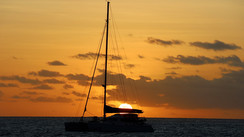

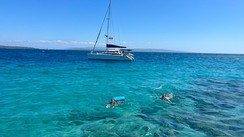
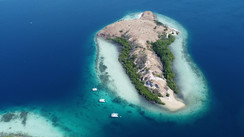
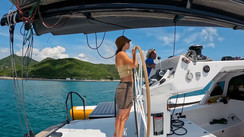
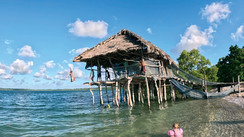
What readers think
Post a comment
No comments to show.